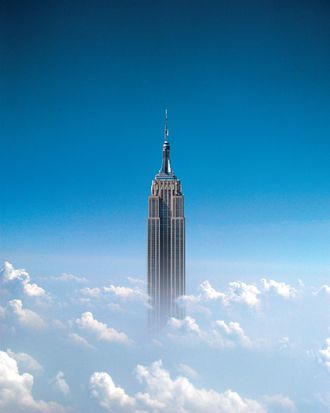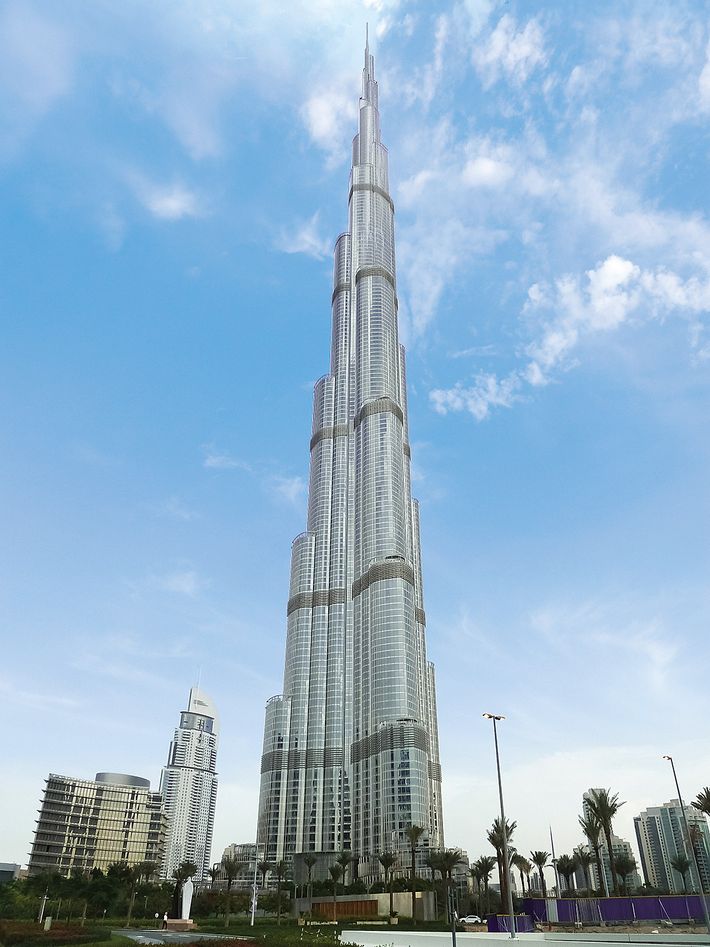
If you’ve sat in an airplane’s window seat, you know what the world looks like from a mile up. It’s that point during takeoff and landing when you can pick out an individual car beetling along a highway; when, on a clear day, you can see the city bleed into its suburbs and trace the outline of a mountain range beyond but still find your favorite bocce court if you know where to look. Individual humans are barely detectable from this height, but humanity’s traces ooze to the horizon. In the not unimaginably distant future, this will be the view from someone’s breakfast nook.
The mile-high skyscraper makes a little more sense to build now than it did when Frank Lloyd Wright designed one nearly 60 years ago. Wright imagined, on the fringes of Chicago, a habitable 528-story sundial called the Illinois. That idea wasn’t buildable then; its successor would still be risky, financially ruinous, slow to construct, and inefficient to operate. But that doesn’t mean a mile-high skyscraper won’t get done. “Going big has been a trend ever since the pyramids. It has little to do with practicalities,” says Jay Siegel, an executive and engineer with Allianz, the company that might one day insure this theoretical Hubris Tower. The technology of supertall buildings is a bit like genetic testing or nuclear energy: a volatile form of power. Technological capacities have outpaced our judgment. We know we can do it, but we don’t know when not to do it. And so some endlessly wealthy mogul, most likely in South Asia or a Gulf emirate, will eventually move into a preposterously expensive penthouse so far above the Earth’s crust that the air is thin and gales hammer at the glass. A mile’s not science fiction. It’s not even an outer limit.
From the Empire State Building in 1931, at 1,250 feet tall, until Taipei 101 in 2004, the roof of the world rose just 400 feet. Then, in 2010, it jumped another 1,000 feet, to the half-mile-high Burj Khalifa, a godlike spike in the desert that looks like a direct descendant of the Illinois. Its usurper is already under construction: the Kingdom Tower in Jeddah, Saudi Arabia, will hit the one-kilometer mark, or 3,280 feet, when it’s completed, theoretically in 2018. The pace of supertall construction has accelerated lately, and if there is some ceiling beyond which nobody will ever build, engineers haven’t found it yet. “I don’t see a limit other than people’s chutzpah — arrogance, actually,” says Ken Lewis, a partner at Skidmore Owings and Merrill who managed the design of One World Trade Center. Arrogance is useful: A sizable segment of the architectural, engineering, and construction professions depends on it for inspiration and employment.
I asked William Baker, the SOM structure guru who figured out how to make the Burj Khalifa stay up, how he would respond if a hypothetical developer with limitless resources came to him and said: Okay, time to quit screwing around with ten stories there and 100 feet there. Let’s build the mile-high tower.
“Yup,” he answered. “Okay.” (Baker is from Missouri, and he is frugal with words.)
“How about a mile and a quarter?” I pressed.
“Yeah, we’d figure it out.”
And at what point do you stop being able to figure it out?
“I’m not sure. A mile would be twice the Burj. For now, let’s double what we have. Then we can figure out how to double it again.” So, two miles, then?

It’s easy to wave away architects’ impractical fancies: Wright’s Illinois, but also X-Seed 4000, a monstrous 2.5-mile-high takeoff of the Eiffel Tower, and TRY 2004, a pyramid-shaped vertical city, both designed to rear above Tokyo. But there is something irresistible about the matter-of-factness with which an experienced structural engineer like Baker suggests a whole new era of loftiness. For Baker, the megatall tower is really a new species, not just an inflated version of the skyscrapers of yore. He cites the biologist D’Arcy Thompson, who, in his 1917 classic On Growth and Form, described with mathematical elegance the relationships between shape and size in nature. Different orders of magnitude require different skeletal structures. You can’t just inflate the Empire State Building and get its successor, any more than you can multiply a mouse to produce an elephant. Double the height and width of a blocky tower and you wind up with a dark-bellied leviathan, in which many occupants labor so far from windows that they might as well be stocking shelves at Amazon. Instead, engineers have had to invent new structures that narrow from a sprawling mall below to a cozy penthouse palace.
That tapering comes at a cost. Each additional floor on top requires expensive extra concrete and steel down below, but gives back little. “When you look at the square footage gained by going up higher, at some point you could just build another building next door. There is a height where it no longer becomes economically feasible,” says Siegel, the Allianz executive. For a century, a skyscraper’s size was defined by an inexorable formula: The higher the cost of land, the more stories needed to pay for it. At a certain point — where, exactly, is a moving target — this logic falls apart. Instead, another impulse takes over, a craving even more primal than making money: the need for immensity.
Building to high elevations may seem like a rational enterprise, but it’s more like an extreme sport, filled with potential calamity. Piping junctions can snap, high-pressure hoses burst, cranes collapse, fires rage beyond reach. Wet concrete can start to harden on its way up to its destination. Even a minute shift in the earth below the foundations can knock a building askew. In the first years of skyscraper development, the greatest limiter of height was gravity. But as towers poked farther and farther into the sky, engineers had to deal with the more erratic forces of earthquakes and weather. A light breeze on the fourth floor may be a gale on the 104th, and even mild vibrations can make people feel ill. Wind slams into a tower from one side, then splits into two arms. When the two streams whip around the building toward each other, they create whirlpools that spin off in a regular rhythm (a phenomenon called vortex shedding). Under the right conditions, the building will start snapping back and forth or humming like a guy wire, the vibrations increasing to intolerable levels. One common way to counteract that phenomenon is with a tuned mass damper, an immense weight suspended in the upper stories. A popular YouTube video shows how, during the Szechuan earthquake of 2008, a 730-ton ball of steel at the top of Taipei 101 swayed in its harness like an infant in a baby bouncer. When the top pitched left, the ball swung right, keeping the tower from moving much at all.
Wind can also sculpt a high-tech tower the way it does a Bryce Canyon hoodoo. After placing a scale model in a wind tunnel, architects try to disperse the onslaught by carving channels through the tower, adding fins, and softening curves. If supertall towers have gotten less symmetrical and more textured, that’s not all preening: It’s also a way of “confusing the wind” — a poetic phrase for creating calculated chaos.
The multiplicity of forces waging war on high-altitude architecture means that supertall buildings are necessarily designed from the guts outward. For decades, the tallest buildings have been collections of separate structures, fused in ever more complex ways. Chicago’s Willis (née Sears) Tower consists of nine square tubes bundled together like fasces. More recent colossi make use of the core-and-outrigger system, in which an immense steel truss links a powerful concrete trunk to thick columns at the edges. For the Burj Khalifa, Baker worked with the ex-SOM architect Adrian Smith to develop a buttressed core, in which three companion structures, each with its own corridor, share a central spine, rather like three lanky drunks leaning on a lamppost. A mile-high skyscraper would most likely be a cheerleading squad of three or four towers standing hip to hip with a skinny companion on their shoulders. Which system gets used for which tower depends not just on its height but on how much land is available at the base, how close the nearest seismic fault line is, and the proportion of spaces for work and play. Offices require large, column-free floors that can be filled with a honeycomb of cubicles. Residences, on the other hand, have smaller footprints divided into rooms, making it possible to hide columns in the walls — which is one reason condos can be so skinny and office towers are usually so fat.
Persuading a megastructure to remain vertical is only step one; the next job is getting thousands, even tens of thousands, of people in and out of it every day without each of them having to budget elevator time. Steel cables are strong but so thick and heavy that a coil longer than about 1,600 feet becomes unmanageable. That simple physical fact dictates that getting up to, say, the 120th floor requires switching elevators — which means designing a sky lobby, fattening the core with additional shafts, and slowing down everyone’s vertical commute. Or that used to be true. Two years ago, the Finnish elevator company Kone inaugurated a lightweight carbon-fiber cable called UltraRope, which, at least in theory, could double the length of a single elevator ride to a full kilometer. If it lives up to its billing, that could make high-rises thinner, lighter, and far more energy-efficient — so that if you lived in a penthouse two miles up, you’d have to change elevators only twice.
At this point, the limiting factor is not the technology of vertical transportation, but the human body. A fast elevator can glide smoothly and silently into the skies, but if you’re riding it with a head cold, it will be murder on the sinuses. Nothing a Finnish engineer can do about that, except possibly pressurize the cab, though for now that remains a futuristic form of comfort. Human beings may never get used to the strangeness of seeking shelter above the clouds.
I haven’t visited the Burj Khalifa. The tallest man-made point I’ve experienced is the top of One World Trade, a relatively stumpy 1,400 feet without its antenna. But already from there, the view is practically astronautical. The city below recedes into abstraction, a gridded 3-D map like an obsessively detailed blowup of the Panorama in the Queens Museum. The effect is not grandeur but its opposite: The inhabited world has been miniaturized for your viewing pleasure. The vista is exciting, but this is a doll’s-house universe: It’s hard to understand the desire to step back even farther, to increase the volume of air between yourself and the life below, or to gaze even deeper into the exurbs. If you can already see from the Poconos to Great Neck, how would a glimpse of Syosset intensify the majesty?
That’s as high as Manhattan will climb for the foreseeable future. In the next half-dozen years, the Nordstrom Tower on 57th Street, by Adrian Smith and Gordon Gill, and Kohn Pedersen Fox’s One Vanderbilt, a likely neighbor to Grand Central Terminal, will both top out around 1,500 feet. Rafael Viñoly’s 432 Park, which now looks like a skewer in a pincushion, reaches just shy of 1,400. Seen from New York, the notion of a mile-high tower can seem like a distant, screwball real-estate venture, like an indoor ski slope in the desert or a fake Manhattan in China. “If we can build plenty of 50- and 60-story buildings, do we need any 120-story buildings?” asks the architect Jamie von Klemperer, who has an interest in the answer, since his firm, KPF, is designing the 65-story One Vanderbilt.
But just because there are no current plans to push a building’s height from profitable to narcissistic doesn’t mean it won’t happen. Manhattan is where global egos — and foreign money — come to roost, and there’s no telling what monuments they will choose to erect. Even a single Manhattan block could accommodate a 2,500-foot tower. A superblock — say, the one where Madison Square Garden now sits — could support something much bigger than that.
Although the next generation of superskyscrapers is likely to be built in other parts of the planet, they will still affect New York just by existing. The world’s tallest towers are outliers by definition, but a few 1,000-foot towers have already made their 800-foot sidekicks commonplace. Two or three contestants for the mile-high mark will sow an underbrush of half-milers. New York may never again have the world’s highest anything, but those thin-air buildings halfway around the world will surely pull the local skyline upward. The real question is how those taller structures will shape the city below. “The big advances have less to do with ultimate height than with the way skyscrapers meet the ground, the way they’re intertwined with public space or the way public functions get integrated,” von Klemperer says.
That applies to One Vanderbilt, an office building that thousands of people will enter or cross through every day. Its base is stitched to transit, and its design needs government support. It is, in that sense, partly a public building. But a new economic lunacy is reshaping the skyline: the fact that a very few will pay vast sums for a tiny number of apartments that they rarely occupy. Their developers are selling a bizarre mixture of privacy and ostentation, and they require no approvals, which means they have no reason to care what the public thinks. That raises major moral questions. Supertall, superskinny towers benefit hardly anyone, but their impact is citywide. The first time the confluence of technology and economics started reshaping the skyline, the city responded with the 1916 zoning code, which required tall buildings to recede as they climbed so that light and air would penetrate to the city’s lower zones. Those rules didn’t cap height or sap New York’s real-estate energy; rather, they gave us the classic setback tower — the Empire State Building, for example. Now that we see how tall tomorrow’s tallest buildings will be, and how common the runners-up, we must adapt again. We could protect certain view corridors, as London does, or limit the shadows a tower casts, or impose an automatic public review on any building over 1,000 feet. What we need is a new ethics of the skyline — a way to wrestle with the question posed by SOM’s Ken Lewis: “Whom does the sky belong to? Given the density we live in, and given that the sky provides daylight to all of us, does someone else have the right to take it?”
*This article appears in the March 23, 2015 issue of New York Magazine.






























